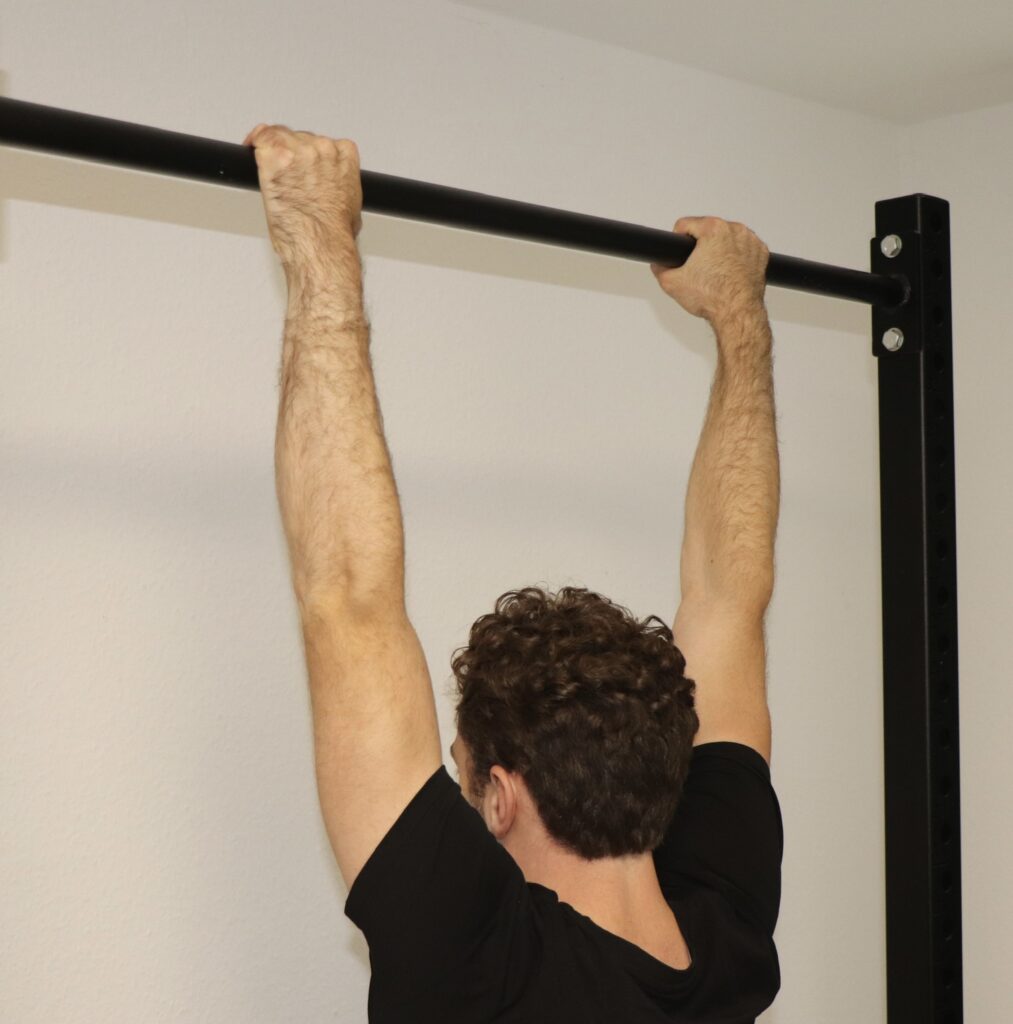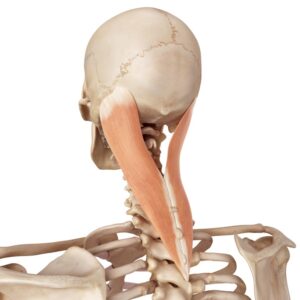In the US, 200 thousand shoulder decompression surgeries are performed every year, although researchers have found that they are not more effective in treating shoulder pain than a placebo.
Shoulder pain is debilitating for many people in sports, everyday life, and even during sleep. John M. Kirsch, MD prescribes a simple exercise to make the pain disappear and prevent unnecessary surgery: Hanging from a bar.
In this article, we present the science behind hanging for shoulder pain, how hanging addresses different causes of shoulder pain, and the exact hanging exercise protocol that Dr. Kirsch uses to cure his patients and enhance their quality of life.
Table of Contents
The content of this article is based on the ideas presented in “Shoulder Pain: The Solution and Prevention” by John M. Kirsch, MD. It is intended for informational purposes only and should not be considered as medical advice. Always consult with a healthcare professional before making any decisions about your health or treatment.
The Advocate of Hanging: John M. Kirsch, MD
John M. Kirsch, MD is an orthopedic surgeon who practiced medicine for over thirty years. When he experienced shoulder issues himself, he discovered the potential benefits of hanging while playing with his child on the playground. As he hung from the monkey bars, a physically painful experience, he had the idea that retraining his body in the overhead position could solve his issue.
Although he had a torn rotator cuff, that he was told he needed surgery for, he healed his shoulder with hanging from a bar and doing a few simple weighted exercises to strengthen his rotator cuffs.
His theory suggests that our ancestors spent a significant amount of time climbing and swinging from tree to tree in forests. Therefore, our shoulders are required to stretch out in the overhead position and utilize their full range of motion. Not regularly hanging from the hands causes shoulder issues.
Dr. Kirsch started to spread the word and prescribed his protocol to people with a variety of shoulder issues. In the Kauai Study, he assessed the effectiveness on 92 subjects with subacromial impingement syndrome, rotator cuff tears, adhesive capsulitis (frozen shoulder), and/or osteoarthritis of the glenohumeral joint. Out of those, 90 were able to return to comfortable daily activities.
Since publishing the book “Shoulder Pain? The Solution & Prevention“, he helped many more people treat their shoulder issues and avoid surgery, as the testimonials show.

Shoulder Anatomy: The Shape of the Acromion
The shoulder’s architecture is quite complex, given its ability to move and rotate the arm in every conceivable direction.
To understand why the hanging exercise can address so many problems, it’s essential to grasp the role of the acromion briefly.

The acromion bends around the head of the humerus. In the space between lie the rotator cuffs. They are attached at the greater tuberosity and the scapula. The degree of bend of the acromion varies and can be relatively straight, slightly bend, or hook shaped. If the acromion is strongly bent, it compresses the rotator cuffs, leading to subacromial impingement syndrome (SIS). Over time, this can put strain on the rotator cuffs and cause a tear.
This is commonly treated with surgical intervention in which part of the acromion is removed to create more space in between it and the humerus. Sometimes, the coracoacromial ligament (CAL) is also partially or fully removed.
Decompression surgeries, often conducted to treat SIS, have been found not to be more effective than a placebo.
According to Dr. Kirsch, the curvature at the end of the acromion is not genetically determined, but is a result of using overhead range of motion. The coracoacromial ligament (CAL) attaches at the acromion and the coracoid process. A tight CAL ligament pulls on the acromion and causes a high degree of bend. A few millimeters of reduced space can already cause compression on the rotator cuffs and, therefore, symptoms of pain.
How Hanging Treats Different Types of Shoulder Pain
Dr. Kirsch has done CT scans on shoulders that were in a simulated hanging position. He found that in the overhead position the acromiohumeral interval — the space between acromion and the humerus — changes in a way that is best described as a joint. He calls this the “acromiohumeral joint”, a new “joint” which has not been recognized as such.
Moreover, hanging from a bar stretches the CAL ligament. By stretching it, the acromion bends back into a more straight shape over time, according to Wolff’s law. This results in more space between acromion and humerus. With just a little more space created, the compression of the rotator cuff stops and there is a relief from the painful symptoms.
Hanging for Shoulder Impingement
The subacromial impingement syndrome (SIS) is caused by a lack of the space between the humerus and the acromion. Compression of the soft tissue in between (e.g. the rotator cuffs) causes pain or discomfort.
According to Dr. Kirsch, hanging from a bar stretches the CAL, reshaping the acromion into a more straight shape. As a result, the shoulder becomes a little more roomy. The symptoms of SIS go away.
Hanging with a Rotator Cuff Tear
Dr. Kirsch claims that a rotator cuff tear is not caused by overuse of the shoulder, as it is commonly believed. Rather, it is a underuse of the shoulder, in particular a lack over overhead motion and brachiating that results in rotator cuff injuries over time. Just like an impingement, rotator cuff tears are caused by the compression due to a lack of space.
The stretching of the CAL and the straightening of the acromion reduce the compressive forces on the rotator cuffs, preventing further damage and allowing them to heal. Smaller tears are likely to heal without surgery.
He says that if you can lift your arm to the horizon, you can safely hang since the rotator cuffs are given more space in the overhead position and are not strained. In his opinion, the rotator cuff is not injured further by hanging.
Hanging for Frozen Shoulder
People suffering from a frozen shoulder (adhesive capsulitis) experience limited mobility in that joint. In the opinion of Dr. Kirsch, this can be treated with hanging too. Gravity pulls the shoulder apart and stretches it. Also the shoulder capsule is stretched which gives relief and helps people to restore normal range of motion their shoulder.
Hanging with Osteoarthritis
Dr. Kirsch has successfully treated patients with osteoarthritis of the glenohumeral joint.
As he describes patients with osteoarthritis often suffer from pain that is not caused by the arthritis itself but by impingement or rotator cuff injuries. In his opinion, it is worth trying to hanging exercise before using other options like shoulder replacement surgery. Joint replacement can often be avoided or delayed.
As he says: “Gravity is free”.
Who Should Avoid the Hanging Exercise?
Dr. Kirsch does not advise hanging for persons with “unstable or dislocating shoulders”, those in “precarious physical health”, or those diagnosed with “severe osteoporosis“.
You should always talk to your doctor before starting any exercise protocol, especially if you have pre-existing medical issues.
Dr Kirsch’s Hanging Exercise Protocol
Here is Dr. Kirsch’s prescribed hanging exercise routine:

- Find an overhead bar you can hang from.
- Use both hands to grip the bar with an overhand (pronated) grip. Your palms are facing forward. This grip is necessary to stretch the CAL.
- Hang from the bar.
- You can place your feet on the floor or a stool to take some weight off and make the exercise easier in the beginning. Tools like lifting straps or gloves can also be of help.
- Relax your shoulders and let your body sink down into a deep, passive hang.
- Endure the discomfort. You are stretching your CAL and slowly reshaping your acromion. Although your shoulder will resist this position, it is what it needs to heal. The discomfort will subside over time.
- Hang for intervals of 10 to 30 seconds, taking rest breaks of around a minute, over a 10 to 15-minute period.
- Repeat the exercise daily. Once your shoulder pain is gone, you can reduce your training volume to one to three times a week.
The hanging exercise is complemented by three simple rotator cuff exercises. They are done with light dumbbells of one to eight pounds for one set of up to 30 to 45 repetitions. Once you are able to complete that many repetitions, progress by increasing the weight.
Side weight lifting exercise:
Forward weight lifting exercise:
Extension weight lifting exercise:
Criticism of Dr. Kirsch’s method
While Dr. Kirsch has popularized the hanging exercise and has helped many, there are also many skeptics of his work.
The first thing they point out is the lack of scientific research and evidence on the effectiveness of hanging to treat shoulder problems. The “Kauai study” done by Dr. Kirsch was never published in a scientific journal and not a lot of effort has been made by other researchers to investigate the hanging exercise further. The evidence is mostly anecdotal.
A pilot study by a Swedish student investigated hanging as a treatment for subacromial shoulder pain and found a positive effect. However, this was done as a master’s thesis on only 6 test subjects. It will need more research to prove the effectiveness of the hanging exercise.
Other people criticize that Dr. Kirsch is a one-trick pony. He has one exercise that he thinks is a treatment for everything. In their opinion, hanging could help a small group of people, but it is probably not a viable treatment for most shoulder issues.
Movement expert Ido Portal highlights both positive and negative aspects in his blog post on hanging. He is an advocate of hanging himself and likes how Dr. Kirsch explains the underlying anatomy of the process.
At the same time, he criticizes the additional weighted exercises. He points out that Dr. Kirsch is not an expert of movement and that his approach is “outdated and poorly described”. In addition, he agrees that people have to go through discomfort in order to achieve positive change, but that going to pain — as Dr. Kirsch instructs — should be avoided.
Conclusion
The hanging exercise has helped a lot of people improve their shoulder pain. While the evidence is only anecdotal, it is worth trying the method yourself, as long as you can safely do so. The risks of hanging from a bar are low.
If there’s a chance the exercise could alleviate pain or even eliminate the need for surgery, why not give it a try?













